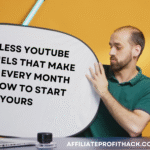Welcome to my article “Why Your Affiliate Marketing Strategy Isn’t Working—and How to Fix It”.
Affiliate marketing sounds like the dream gig, doesn’t it? You promote a few products, share some links, and then sit back as the commissions roll in. Or at least, that’s what the sales pitch says. In reality, many affiliate marketers find themselves staring at their earnings dashboard wondering, Why isn’t this working? Did I break the internet?
In this article, we’re going to break down the top reasons why your affiliate marketing strategy might be failing. From picking the wrong programs to forgetting that your audience is made up of actual humans (not just clicks), we’ll cover it all. And don’t worry—this won’t be a lecture. Think of it more like a friendly intervention with a side of tough love and practical tips. Ready to turn things around? Let’s get started!
My Best Recommended & Proven Way to Make $100-$300 Daily – Watch This FREE Video to START >>>

Choosing the Wrong Affiliate Programs
Let’s get one thing straight: not all affiliate programs are created equal. Sure, that shiny new program promising “unlimited earnings” might look tempting, but if it’s as relevant to your audience as a snowplow is to someone living in the desert, it’s not going to work. Choosing the wrong affiliate program is one of the fastest ways to tank your strategy.
Why It Happens
Many affiliate marketers, especially beginners, fall into the trap of chasing high commissions or trendy products without considering if they’re actually a good fit. It’s like trying to sell gourmet caviar to a group of college students surviving on instant ramen—they’re just not buying it.
Other times, the program itself is the problem. Some affiliate programs have poor tracking systems (hello, lost sales!), low payout rates, or, worse, they just vanish without paying you. If you’ve ever felt like your affiliate efforts are more “volunteer work” than a business, you might be working with the wrong partners.
How to Fix It
- Know Your Audience: Before signing up for any program, ask yourself, Would my audience actually want this? If you’re running a fitness blog, promoting a luxury car brand might not exactly resonate. Stick to programs that align with your niche and audience interests.
- Research the Program: Don’t just jump in because the commission rate looks good. Check reviews, read the fine print, and make sure the program has a solid reputation. Pro tip: if the program sounds too good to be true, it probably is.
- Look Beyond the Payout: Sure, high commissions are great, but they mean nothing if the product doesn’t convert. Go for programs that offer reasonable rates and have a track record of turning clicks into sales.
- Test Before You Commit: Sign up for a program, try the product yourself if possible, and see how well it performs with your audience. If it flops, don’t be afraid to cut ties and move on.
Remember, your goal is to build trust with your audience. Promoting a dodgy affiliate program is like recommending a bad movie—you’ll lose credibility fast. Choose wisely, and your affiliate marketing efforts will thank you.
Neglecting Audience Needs and Trust
If affiliate marketing had a golden rule, it would be this: Your audience comes first. Forgetting that is like bringing a megaphone to a library—it’s disruptive, off-putting, and no one’s going to stick around long enough to hear your message.
Why It Happens
Some affiliate marketers get so caught up in chasing commissions that they forget the people clicking their links are actual humans, not just numbers on a dashboard. This leads to common mistakes, like promoting random products that don’t align with the audience’s needs or flooding every post, email, and tweet with affiliate links.
Picture this: You’ve built a loyal audience of health-conscious readers, and then suddenly, you’re trying to sell them discount pizza ovens. They’ll see right through it, and worse, they might stop trusting you altogether. Trust, once lost, is harder to regain than a lost set of keys in a haystack.
My Best Recommended & Proven Way to Make $100-$300 Daily – Watch This FREE Video to START >>>
How to Fix It
- Know Your Audience (For Real): Take time to understand who your readers are and what they actually need. What problems are they trying to solve? What products or services would genuinely make their lives easier or better? If you’re not sure, ask! Surveys, polls, or even direct feedback in your comments section can work wonders.
- Be Selective With Your Recommendations: Don’t promote every product under the sun just because you can. Choose affiliate products that you would use yourself or genuinely believe in. Your audience will appreciate your integrity, and they’ll trust your recommendations more.
- Provide Value Before Promoting: People don’t visit your blog or follow your social media for ads—they’re looking for solutions, advice, or entertainment. Focus on creating helpful content first, and weave in affiliate recommendations where it makes sense. For example, instead of just dropping a link to a fitness app, write a post about “10 Ways to Stay Fit at Home” and include the app as one of your tips.
- Be Transparent: This one’s non-negotiable. Always disclose when you’re using affiliate links. A simple, “Hey, I earn a small commission if you buy through this link—thanks for supporting me!” goes a long way in maintaining trust. Plus, your audience will appreciate the honesty.
- Engage and Listen: Building trust isn’t a one-way street. Interact with your audience in the comments, respond to their questions, and take their feedback seriously. The more connected they feel to you, the more likely they’ll trust your recommendations.
Remember, your audience isn’t just a means to an end—they’re the backbone of your affiliate marketing success. Treat them with respect, keep their needs in mind, and always prioritize building trust over making a quick buck. After all, a loyal audience is worth far more than a fleeting commission.
Poor Content Strategy
Creating content for affiliate marketing without a plan is like throwing spaghetti at the wall and hoping it sticks. Spoiler alert: it usually doesn’t. A poor content strategy is one of the main culprits behind lackluster affiliate results, and it’s a mistake even experienced marketers make when they’re not paying attention.
Why It Happens
Some marketers treat affiliate content like a sales pitch marathon—Buy this now! Click this link!—with zero regard for value or engagement. Others go to the opposite extreme, creating overly broad or irrelevant content that leaves readers wondering, What was the point of this again?
Then there’s the issue of relying too heavily on one type of content. Blog posts are great, but if they’re all you’re doing, you might be missing out on opportunities to connect with your audience through videos, infographics, or even social media posts.
How to Fix It
- Create Value-Driven Content: Think about what your audience needs help with, and create content that provides solutions. Tutorials, in-depth reviews, “how-to” guides, and product comparisons are all great ways to integrate affiliate links without coming across as pushy.
- Instead of writing “This is the best fitness tracker—buy it here,” try “5 Ways a Fitness Tracker Can Help You Crush Your Health Goals.” Show them the value first; the sale comes naturally after.
- Optimize for SEO: If your content isn’t optimized for search engines, you’re missing out on a ton of potential traffic. Research long-tail keywords your audience is searching for, and strategically incorporate them into your content. Don’t forget meta descriptions, alt text for images, and headings—they’re your best friends in getting noticed by Google.
- Experiment with Formats: Not everyone consumes content the same way. Some people love reading detailed blog posts, while others prefer quick video demonstrations or engaging Instagram reels. Mix it up!
- Try creating a YouTube video tutorial and embedding it in a blog post.
- Share bite-sized tips or product highlights on social media to tease your full content.
- Focus on Quality Over Quantity: It’s tempting to churn out content like a factory, but if it’s low quality, it’s not doing you any favors. A few well-researched, valuable pieces of content will always outperform dozens of rushed, generic posts.
- Include Clear and Compelling CTAs: A great piece of content is wasted if your audience doesn’t know what to do next. Be strategic with your call-to-action (CTA). Instead of “Click here to buy,” try something more engaging, like “Ready to take your fitness game to the next level? Check out my favorite tracker here!”
- Analyze and Improve: Content strategy isn’t a “set it and forget it” deal. Use tools like Google Analytics to see which types of posts are driving traffic and conversions. Are readers spending time on your product reviews but bouncing off listicles? Adjust your strategy accordingly.
Good content isn’t just about selling—it’s about building trust, providing value, and creating a connection with your audience. Get your strategy right, and you’ll see not only better results but also a more engaged and loyal following. And hey, isn’t that the dream?
Ineffective Traffic Generation
Traffic—the lifeblood of affiliate marketing. You could have the best content in the world and promote the most irresistible products, but if no one’s showing up to see it, your strategy is stuck in the slow lane. Generating traffic can feel like shouting into the void, but don’t worry—there’s a reason why it’s not working, and there are fixes for it.
Why It Happens
Many affiliate marketers rely too heavily on a single traffic source, like social media or paid ads. While these channels can work, they’re not foolproof. Social media algorithms change more often than your favorite streaming service drops new shows, and paid ads can quickly drain your budget if they’re not targeted properly.
Others completely ignore organic traffic (hello, SEO!) or fail to engage audiences consistently. And then there’s the “spray and pray” approach: posting everywhere without a clear strategy and hoping something takes off. Spoiler alert—it rarely does.
My Best Recommended & Proven Way to Make $100-$300 Daily – Watch This FREE Video to START >>>
How to Fix It
- Diversify Your Traffic Sources: Pinning all your hopes on one platform is like betting your life savings on one horse—it’s risky. Instead, spread your efforts across multiple channels:
- SEO: Optimize your blog or website for keywords your audience is searching for. Organic traffic might take time, but it’s worth the investment.
- Social Media: Leverage platforms like Instagram, Pinterest, or TikTok, especially if your niche has a strong visual appeal. Tailor your content to fit each platform’s strengths.
- Email Marketing: Build an email list and nurture it with valuable content and occasional affiliate recommendations. Unlike social media, you own your email list, so no algorithm can hold you hostage.
- Master SEO Basics: If you’re not showing up on Google, you’re missing out on a massive audience. Use tools like Google Keyword Planner or Ubersuggest to find search terms your target audience uses. Then create content around those keywords, ensuring your titles, headers, and meta descriptions are optimized to grab attention.
- Leverage Paid Ads Wisely: Paid ads can work wonders—if you use them right. Target specific audiences, monitor your ad performance, and ensure the ROI justifies the spend. Don’t throw money at ads and hope for the best. Test different creatives, headlines, and audiences to find what converts.
- Engage Where Your Audience Hangs Out: If you’re promoting products for gamers but you’re posting on LinkedIn, you might want to rethink your approach. Go where your audience is—whether that’s Reddit, Facebook groups, or niche forums. Engage genuinely and share your content in a way that feels helpful, not spammy.
- Repurpose Your Content: Don’t let good content gather dust after one use. Turn a blog post into an infographic, a video, or a carousel post on Instagram. Repurposing content allows you to reach different audiences without reinventing the wheel.
- Use Analytics to Your Advantage: Not all traffic is created equal. Use tools like Google Analytics or social media insights to track where your traffic is coming from, how it behaves, and which sources drive conversions. Double down on what’s working and tweak what’s not.
Driving traffic isn’t just about numbers—it’s about bringing the right people to your content. With a little strategy, some diversification, and a sprinkle of creativity, you can turn a trickle of visitors into a steady stream. And hey, the more people you bring in, the more likely your affiliate links will get some love. Win-win!
Lack of Testing and Optimization
Affiliate marketing without testing and optimization is like cooking without tasting the food—you’re just hoping it works out, but let’s face it, you might end up with a disaster. Many affiliate marketers fall into the trap of setting up campaigns, sprinkling in some links, and then walking away, expecting passive income to magically appear. Spoiler: it doesn’t work like that.
Why It Happens
Testing and optimization sound technical, and let’s be real, a little boring. Who wouldn’t rather focus on writing killer blog posts or brainstorming the next big idea? But skipping this step is like driving blindfolded: you won’t know what’s working, what’s not, or how to get to where you want to go.
Another common reason? Analysis paralysis. With so many metrics to track—click-through rates (CTR), conversion rates, bounce rates—it’s easy to get overwhelmed and do nothing. But here’s the truth: without data, you’re just guessing.
How to Fix It
- Track Key Metrics: You don’t need to become a data scientist, but you do need to monitor the right numbers. Start with the basics:
- CTR: Are people clicking your affiliate links? If not, your call-to-action (CTA) might need some love.
- Conversion Rate: How many clicks are turning into sales? A low rate might mean your product isn’t resonating, or the landing page needs improvement.
- Bounce Rate: If visitors leave your page faster than a dog runs after a squirrel, your content might not be engaging enough.
- A/B Test Everything: Sometimes, small tweaks can make a big difference. Test different variations of:
- Headlines: Try a catchy question versus a straightforward statement.
- CTAs: Move your affiliate link higher on the page, change the wording, or experiment with buttons instead of hyperlinks.
- Content Formats: See if your audience prefers a written review, a video demo, or a comparison chart. Pro tip: Don’t test too many things at once. Stick to one variable at a time so you know what’s making the impact.
- Optimize for Mobile: A large chunk of your audience is probably browsing on their phones. If your site isn’t mobile-friendly, you’re leaving money on the table. Ensure your links, buttons, and pages look great and function smoothly on smaller screens.
- Use Analytics Tools: Tools like Google Analytics, Hotjar, or even your affiliate program’s dashboard can give you insights into what’s working and what’s not. Look at traffic sources, heatmaps, and user behavior to refine your strategy.
- Refine Your Strategy Based on Data: Optimization isn’t a one-and-done deal—it’s an ongoing process. If a product isn’t converting, consider swapping it out for something else. If certain blog posts consistently drive traffic, create more content around similar topics or update the post with fresh info.
- Celebrate Small Wins: Testing and optimization can feel like a grind, so take a moment to celebrate when something works. A 5% boost in your CTR or a jump in conversions isn’t just a win—it’s proof that your efforts are paying off.
Affiliate marketing isn’t about throwing spaghetti at the wall; it’s about figuring out which noodle sticks and why. Testing and optimization might sound tedious, but they’re your secret weapon for turning a decent strategy into a wildly successful one. So, roll up your sleeves, dive into the data, and get ready to watch your results skyrocket!
Conclusion
Affiliate marketing can sometimes feel like trying to solve a Rubik’s Cube while blindfolded—frustrating, confusing, and occasionally tempting to just toss out the window. But here’s the good news: if your affiliate marketing strategy isn’t working, it’s not the end of the road. It just means you’ve got some tweaks to make, and now you know exactly where to start.
Whether it’s choosing the wrong programs (hint: no one’s buying that diamond-studded toothbrush), forgetting to focus on your audience (they’re humans, not clicks!), or neglecting SEO and content quality (Google sees all, my friend), every misstep is an opportunity to improve. The key is to approach affiliate marketing like the dynamic process it is—always learning, testing, and optimizing.
Here’s the bottom line: success in affiliate marketing doesn’t come from luck; it comes from strategy. Build trust with your audience, deliver value through stellar content, and don’t be afraid to dive into the data to see what’s working (and what isn’t). With a little effort and a lot of patience, you can turn those crickets on your earnings dashboard into the sweet cha-ching of commissions rolling in.
My Best Recommended & Proven Way to Make $100-$300 Daily – Watch This FREE Video to START >>>
So, take a deep breath, grab your favorite caffeinated beverage, and get to work. Your next affiliate win is closer than you think—it’s just waiting for you to fine-tune your strategy and give it a little extra love. And who knows? With these tips in hand, your affiliate marketing success story might just be the next one we’re all raving about.
Thank you for reading my article “Why Your Affiliate Marketing Strategy Isn’t Working—and How to Fix It” till the end. Hope it helped you. See you with another article.










